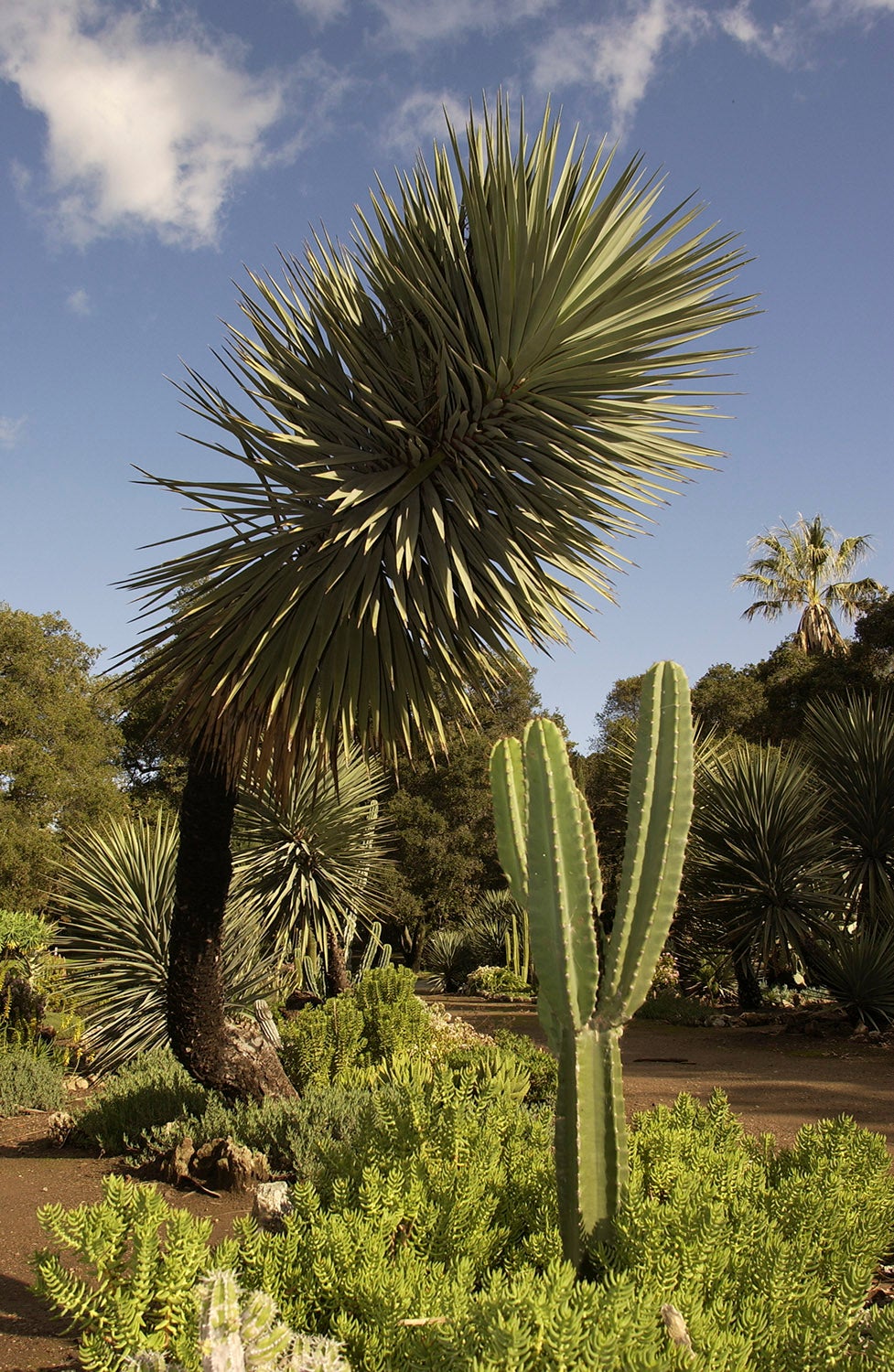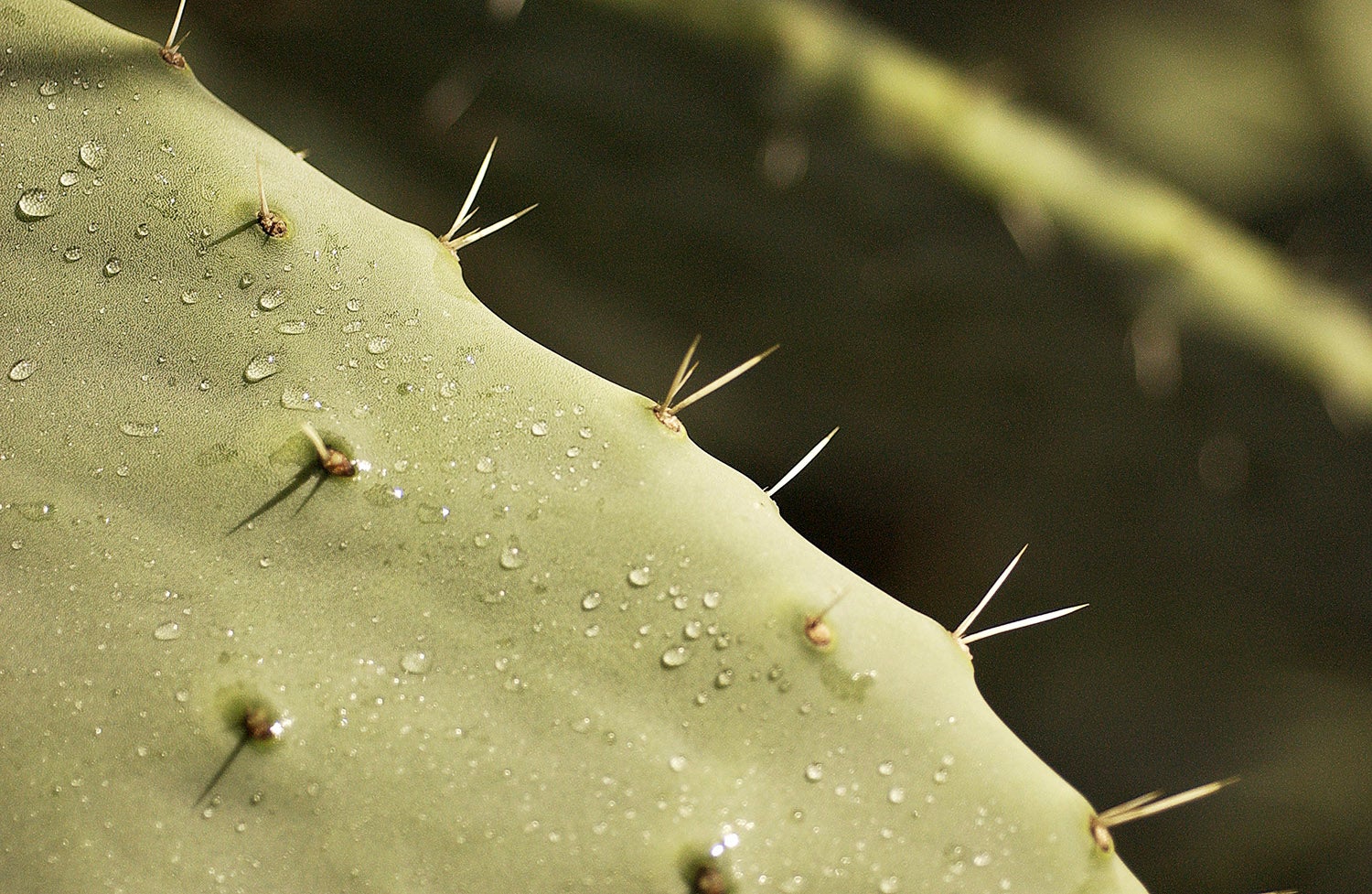When cactus-lover Marsha McPheeters first visited the Arizona Garden in the Arboretum four years ago, there didn’t seem to be much there that would bring her back.

Christy Smith, left, who coordinates volunteers for the Arizona Garden, and library specialist Julie Cain, right, are working at restoring the cactus garden in the Arboretum. (Image credit: L.A. Cicero)
Planted with saguaro and other rare cacti and succulents in the 1880s but neglected for decades, in 1997 the plot was more ruin than garden. Many of the original plants had died, while others were growing like weeds. The serpentinite rocks that outlined the garden’s 58 beds were half-buried and the area was blanketed with brush and drifts of dead oak leaves.
Ordinarily, “I would have walked out there and said, ‘This is shot. Somebody had something here once, but it’s gone now,'” recalled McPheeters, a Healdsburg resident and member of the San Francisco Succulent and Cactus Society. “But the agaves called to me.”
Mixed in with the surviving yucca and towering prickly pear plants were magnificent old agaves, some nearly 25 feet in diameter. “I found a cause,” said McPheeters, an agave collector.
Nearly every month since then, she’s made the five-hour round-trip to campus to join a small group of volunteers and staff who have patiently and painstakingly brought the Victorian garden back to life. The restoration is a collaborative project between the San Francisco Succulent and Cactus Society and Facilities Operations, said Christy Smith, who works half time as a library specialist and half time coordinating work at the garden.
Most of the garden’s 58 beds have had their rock borders rebuilt and have been replanted with hundreds of species of artfully placed cacti and succulents. The rock borders follow the garden’s historic, symmetrical lines: a central walkway lined with columns of cacti and cypress trees, and curved paths leading around beds shaped like moons and stars.
When visitors come across the unmarked garden, tucked a few hundred feet away from the Mausoleum, they are often astonished both by its exotic beauty and that such a place is hidden away on campus, McPheeters said. “It’s such a shock to find it here inside the trees. [The garden] has such beautiful geometry and strange and wonderful plants. There are very few other gardens like it anywhere.”
The garden’s roots
Designed by Rudolph Ulrich, who created a similar, now-vanished garden in Golden Gate Park in San Francisco, the 30,000-square-foot plot was planted between 1880 and 1883 as part of the landscaping that was to surround the Stanfords’ new country house. Plans for the house were scrapped after the death of the Stanfords’ only child, Leland Jr., but the garden remained and became part of the campus landscape when the university was opened in 1891.
Julie Cain, operations manager for the Engineering Library, began working on the garden in 1998, when the restoration project was just getting off the ground. Cain, a library specialist with a passion for garden history and horticulture, spent 10 hours a week for two years digging in the university archives for information about the history of the neglected garden. Facilities Operations initially funded Cain’s research, but she kept working on the project as a volunteer after she resigned the part-time gardening position.

This undated photograph was likely taken around 1900, when the Arizona Garden was in its initial glory. The current restoration project has recreated the original garden’s outlines. (Image credit: Stanford University Archives)
The cactus garden – formally named the Arizona Garden – was very much a product of its time and place, Cain said. “Everybody had big estates and big elaborate gardens built in the Victorian style of ‘I have money,'” she said. Gardens filled with rare botanical collections were the ultimate status symbol in the late 19th century, when it was possible to transport live plants across long distances but only at great expense.
Leland Stanford was not only rich, he had a railroad line at his disposal, Cain pointed out. Stanford sent Ulrich to the Sonoran Desert, where he collected specimens with a horse-drawn wagon and shipped them back to California by rail.
Cain’s research showed the garden was regularly maintained until the 1920s, first by university gardener Thomas Douglas and then by two men who were formerly part of the Stanfords’ personal staff, Chung and Ah Wah. After the Wahs retired to China in 1926, the cactus garden is rarely mentioned in university records, Cain said. The garden “kind of quietly sat there.” (Not too quietly: “I have a lot of alumni come to me and say this was the big making-out place in the 1930s and 1940s,” she said.) After World War II, university groundskeepers kept the area free of trash, but basically, “there was a whole lot of nothing,” Cain said.
The Arizona Garden is one of the most significant historical elements in the campus landscape, but when restoration began in the late 1990s, “it couldn’t have gotten any worse,” said Herb Fong, grounds supervisor. (One visitor went looking for the old garden and found it only when she tripped over broken rock, Cain said.)
The restoration was part of a larger plan, initiated by Chris Christofferson, associate vice provost and director of Facilities Operations, to rehabilitate the neglected Mausoleum and a nearby Angel of Grief statue erected by Jane Stanford. Although Fong and campus archeologist Laura Jones lent the project plenty of expertise, funds were limited. With little money for repair work, let alone the purchase of plants, Fong asked members of the San Francisco Succulent and Cactus Society to take on the restoration as a volunteer project.
A volunteer effort
Society members and other volunteers have donated plants, expertise and labor worth tens of thousands of dollars, Fong said. The third Saturday of every month is a workday, when a half-dozen or so volunteers meet to plant, weed, lug rocks and help with seasonal chores like winterizing. (Many plants are protected from the cold by plastic covers that look a little like shower caps.)
Volunteers also take on special projects, like the time McPheeters and her husband drove a 22-foot-long truck filled with golden barrel cactus from a Santa Barbara garden. “This project absolutely couldn’t happen without volunteers,” Smith said.
One such volunteer is Matthew Footer, a research associate at the Theriot Lab in the Department of Biochemistry, where he studies cell mobility by moving microscopic amounts of liquid from test tube to test tube. It’s a nice change to help wrestle a 300-pound cactus into place or to load a wheelbarrow with pruned limbs from a 15-foot-high prickly pear cactus, he said. “And I like a little danger,” he joked. (Smith keeps spare pairs of leather work gloves and a first aid kit on hand, out of respect for the cacti.)
Smith and volunteers are scrupulous about following the original contours of the bed – a misplaced rock wall was moved 8 feet when the mistake was discovered – and the center bed has been restored as closely as possible to the original.
A number of historic photographs existed to help guide restoration of the center bed, but such documentation isn’t available for the whole garden, Smith said. It would be impractical to create an exact reproduction, even if it were possible, she said.
Some plants, like the saguaro that once lined the central walkway and are found only in the Sonoran Desert, are prohibitively expensive. And since many of the plants used by Ulrich, including the frost-tender saguaro, didn’t survive the wet and chilly winters, it wouldn’t make sense to plant them here again anyway, Smith said.
The garden is divided generally into two sections: The Eastern Hemisphere section is planted with aloes, jade plants and other succulents found in Europe, Asia and Africa, and the Western Hemisphere section holds cacti native to the Americas. The boundaries aren’t strict ones, since historic plants, which make up about 10 to 15 percent of the plantings, were left where they originally were planted, Smith said.
Garden designer Ulrich also gave little thought to the cost of garden upkeep and mixed with abandon plants with different water requirements, Smith said. “We don’t have the luxury of unlimited resources to maintain the garden, so we’re using plants that are available now, are relatively hardy and that don’t require too much water.”
One of the appealing aspects of the project is the potential for using the century-old garden as a way to teach contemporary visitors the benefits of landscaping with plants that require little water, McPheeters said. The temperature at her own hillside cactus garden outside Healdsburg sometimes reaches 110 degrees in the summer. “I never have to water,” she said.
McPheeters said she does wish the university would put up signs directing visitors to the garden. “It’s not fair that it’s a secret,” she said.
“I’m so proud of Stanford for supporting the rehabilitation. This was a once-in-a-lifetime opportunity. It’ll be here for another 50 years – or more.”
Designing the Arizona Garden’s restoration
Video by Jack Hubbard
For more information, including a map of the Arizona Garden, visit the Land, Buildings & Real Estate website.


